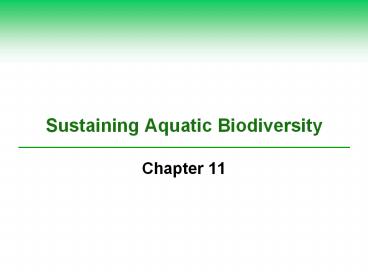Sustaining%20Aquatic%20Biodiversity - PowerPoint PPT Presentation
Title:
Sustaining%20Aquatic%20Biodiversity
Description:
Sustaining Aquatic Biodiversity Chapter 11 * 11-1 What Are the Major Threats to Aquatic Biodiversity? Concept 11-1 Aquatic species are threatened by habitat loss ... – PowerPoint PPT presentation
Number of Views:230
Avg rating:3.0/5.0
Title: Sustaining%20Aquatic%20Biodiversity
1
Sustaining Aquatic Biodiversity
- Chapter 11
2
11-1 What Are the Major Threats to Aquatic
Biodiversity?
- Concept 11-1 Aquatic species are threatened by
habitat loss, invasive species, pollution,
climate change, and overexploitation, all made
worse by the growth of the human population.
3
We Have Much to Learn about Aquatic Biodiversity
- We know fairly little about the biodiversity of
the worlds marine and freshwater systems. - The greatest marine biodiversity occurs in coral
reefs, estuaries and the deep ocean floor. - Biodiversity is higher near the coast and bottom
because of habitat and food source variety.
4
Human Activities Are Destroying and Degrading
Aquatic Habitats
- Just remember H.I.P.P.C.O.!!
- Habitat destruction
- Human activities have destroyed, disrupted or
degraded a large proportion of the worlds
coastal, marine and freshwater ecosystems. - Approximately 20 of the world's coral reefs have
been destroyed. - We have destroyed more than 1/3 of the worlds
mangrove forests for shipping lanes. - Freshwater aquatic zones are also affected
- Dams and excessive water withdrawal from
rivers/lakes
5
Invasive Species, Population Growth, and
Pollution Can Reduce Aquatic Biodiversity
- Invasive species are an increasing threat to
marine and freshwater biodiversity.
- Bioinvaders are blamed for about 2/3 of fish
extinctions in the U.S. between 1900-2000.
- Almost half of the worlds Population lives on or
near a coastal zone and 80 of ocean water. - Pollution comes from land-based human activities.
- Nitrates and phosphates mainly from fertilizers
enter water - Leads to eutrophication
- Toxic pollutants from industrial and urban areas
6
Climate Change Is a Growing Threat
- Climate change as a result of global warming will
cause sea levels to rise and aquatic biodiversity
to be threatened. - Water too warm for coral reefs
- Swamp some low-lying islands
- Drown many highly productive coastal wetlands
7
Overfishing and Extinction Gone Fishing, Fish
Gone
- Overfishing
- About 75 of the worlds commercially valuable
marine fish species are overfished or fished near
their sustainable limits. - Big fish are becoming scarce.
- Smaller fish are next.
- Commercial extinction
- so few exist that it is no longer profitable to
continue
- Bycatch organisms caught unintentionally in
nets - We throw away 30 of the fish we catch.
8
Major Commercial Fishing Methods Used to Harvest
Various Marine Species
Trawler damage
9
11-2 How Can We Protect and Sustain Marine
Biodiversity?
- Concept 11-2 We can help to sustain marine
biodiversity by using laws and economic
incentives to protect species, setting aside
marine reserves to protect ecosystems, and using
community-based integrated coastal management.
10
Legal Protection of Some Endangered and
Threatened Marine Species
- Why is it hard to protect marine biodiversity?
- Human ecological footprint and fishprint are
expanding - Much of the damage in the ocean is not visible
- The oceans are incorrectly viewed as an
inexhaustible resource - Most of the ocean lies outside the legal
jurisdiction of any country
11
Legal Protection of Some Endangered and
Threatened Marine Species
- Laws, international treaties, and education can
help reduce the extinction of marine species. - CITIES, ESA, etc.
- Since 1989 the U.S. government has required
shrimp trawlers to use turtle exclusion devices. - Sea turtle tourism brings in almost three times
as much money as the sale of turtle products. - Dolphin Safe tuna
12
Case Study Protecting Whales A Success Story
So Far
- International Whaling Commission (IWC)
- After many of the worlds whale species were
overharvested, commercial whaling was banned in
1986. - Annual harvest dropped from 42,000 to 1,300
- Whale populations have rebounded so much that
some countries are contemplating hunting again.
13
Marine Sanctuaries Protect Ecosystems and Species
- Exclusive economic zones
- A countrys offshore fishing zone extends 200
miles from the shore - This area is under their jurisdiction and is
their responsibility - High seas beyond legal jurisdiction
- Difficult to monitor and enforce international
treaties
14
Establishing a Global Network of Marine
ReservesAn Ecosystem Approach
- Marine reserves areas of the ocean that are
closed to commercial fishing, dredging, mining
and waste disposal - Less harmful activities allowed
- E.g., recreational boating and shipping
- Fully protected marine reserves make up less than
0.3 of the worlds ocean area.
- Studies show that fish populations double, size
grows by 30, reproduction triples, and species
diversity increases by 25.
- Integrated Coastal Management conservation
efforts and methods need to customized to the
specific region/ecosystem being protected.
15
11-3 How Should We Manage and Sustain Marine
Fisheries?
- Concept 11-3 Sustaining marine fisheries will
require improved monitoring of fish populations,
cooperative fisheries management among
communities and nations, reduction of fishing
subsidies, and careful consumer choices in
seafood markets.
16
11-3 How Should We Manage and Sustain Marine
Fisheries?
- Maximum sustained yield (MSY)
- The maximum that can be harvested without causing
a population drop - Optimum sustained yield (OSY)
- Recalculates MSY taking into account the
interactions with other species and allows for
more room for error.































